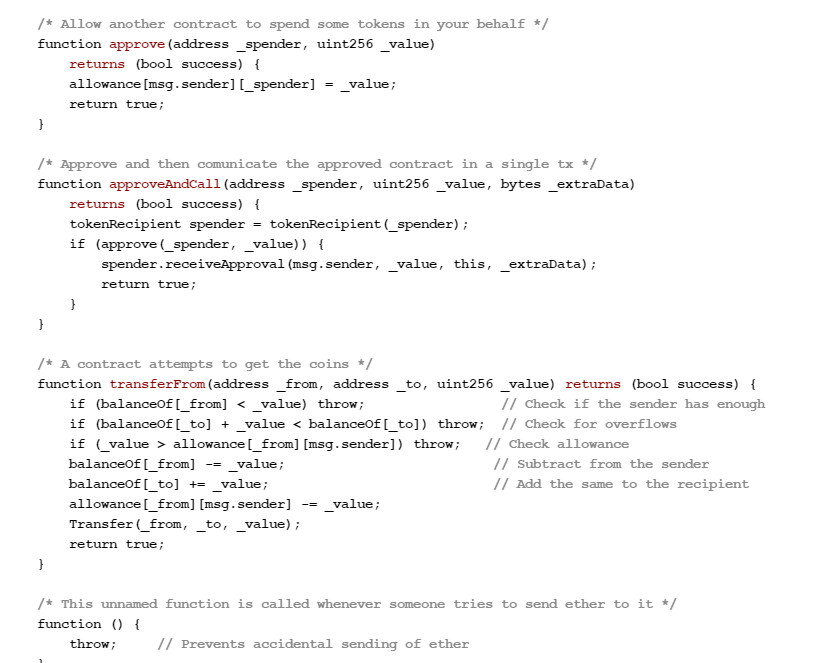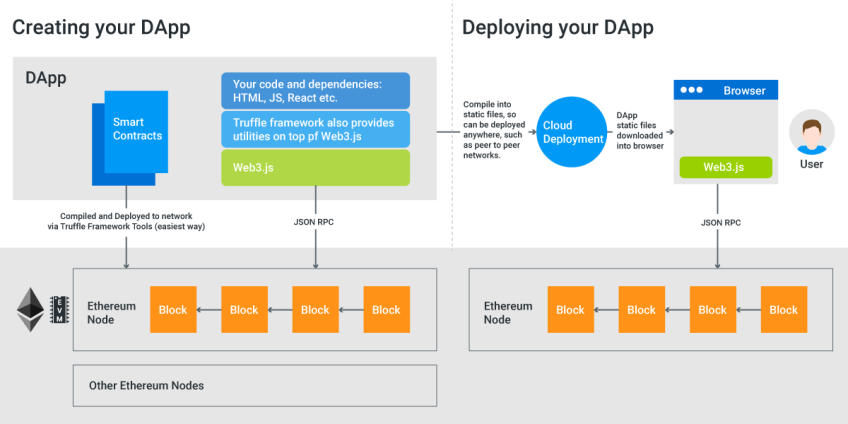How to Build a DApp | 5 Steps | Beginner’s Guide

Let’s cut to the chase.
You’re here because you want to learn how to build a DApp or a decentralized application. The good news is that there isn’t much difference between building a DApp and developing a traditional app.
Still, both applications aren’t the same. And there are some nuances you should know before jumping into your development project.
#What is a DApp (decentralized app)?
A DApp, or a decentralized application, is a type of application that runs on a blockchain network. All that means is that these apps operate on a peer-to-peer (P2P) network of computers. The cool thing about DApps is that they can run autonomously.
 How does blockchain work? Source: geeksforgeeks.org
How does blockchain work? Source: geeksforgeeks.org
Much like cryptocurrency, these apps have no single authority and rely on smart contracts. A smart contract is a computer program that automatically completes an assignment.
 How does a smart contract work? Source: geeksforgeeks.com
How does a smart contract work? Source: geeksforgeeks.com
Whether that directive authorizes a financial transaction or documents in-app events, smart contracts are the fundamental basis for DApps.
Here are some fundamental criteria for an application to be considered a DApp:
- Decentralized architecture: The application's backend code runs on a decentralized peer-to-peer network (rather than centralized servers).
- Open source: The source code is available to anyone to view and contribute to its codebase.
- Incentive: A token or a cryptographic incentive system for those who contribute and maintain the network.
- Consensus mechanism: Use consensus algorithms to agree upon the validity of transactions. Common consensus algorithms include Proof of Work (PoW) and Proof of Stake (PoS).
For data storage, some DApps may use the blockchain itself. But the blockchain isn’t great at storing a lot of data. So many opt for off-chain solutions, such as a cloud data warehouse.
This off-chain solution provides a variety of advantages when working with a lot of data:
- Cost-efficiency
- Scalability
- Reliability
- Flexibility
Some of the most popular DApps with a lot of data include Uniswap, OpenSea, PancakeSwap, and Step App, among others.
Set up your Web3 server in minutes
Optimize cost and performance with custom or pre-built dedicated bare metal servers for blockchain workloads. High uptime, instant 24/7 support, pay in crypto.
#Difference between centralized vs decentralized apps
The answer to this question is also pretty interesting. You wouldn’t be able to tell the difference based on the app's user interface. People, of course, use traditional apps every day to write emails and check their bank account balances.
Users can rely on DApps to run the same functions. Both apps depend on servers to synchronize data in real-time so people can use them on the go. But that’s where the similarities end.
 Centralized vs decentralized network. Source: aceinforway.com
Centralized vs decentralized network. Source: aceinforway.com
As we mentioned before, DApps run on a decentralized network. That’s not true for traditional apps managed on remote servers by their creators. To put it simply, the creator has full autonomy over the app.
You can only perform the functions they dictate. For example, if you’re using Microsoft Office, you don’t have much freedom over the entire product. Microsoft runs this product and gives users specific features they can employ.
DApps are a completely different concept. Here are some key takeaways as to why:
- DApps align with Web 3.0. This concept is a new version of the internet that’s completely decentralized and open to everyone.
- With its decentralized architecture, DApps return power back to users. How? Removing third parties and building a high amount of trust with DApp users.
- DApps usually have some sort of economic model embedded in their back end. Most of these applications run on crypto tokens, giving each user a stake in the entire app.
Traditional apps and DApps typically have no front-end differences.
By definition, a DApp can't be hosted on a centralized server, as for an app to be considered fully decentralized, it must have its backend code running on a decentralized peer-to-peer network like Ethereum or Solana.
However, the frontend user interface of a DApp may be hosted on a centralized server for performance and efficiency benefits. But the core backend code and data storage still must be decentralized to qualify as a true DApp.
Similarities end when the back-end of both apps is concerned.
Now that we’ve covered the basics of DApps, let’s review some pros and cons of building your custom app.
#Why create a DApp: Pros and cons of building a decentralized app
If you’ve come this far into learning how to build a DApp or a decentralized app, you’re either thinking:
- DApps sound like a much better alternative than a traditional app. (It’s cool and trendy).
- Or what is the point of building decentralized software?
Regardless, reviewing the pros and cons of creating a DApp will help give you the full view of how to approach your project.
#Pros of building a decentralized application
There are a variety of benefits to building a DApp. Here are a few pros for why you should learn how to build a DApp:
- Complete autonomy: The greatest benefit of decentralized software is its open-source nature. Since developers and users can all interact with each other, this means everyone can pay low transaction fees and make in-app improvements.
- Excellent uptime: Smart contracts run 24/7 allowing DApps to operate flawlessly with very minimal downtime.
- Incentive mechanisms: Users flock to decentralized apps to earn tokens that they can cash out for fiat in the future.
- Infallible security and privacy: Anonymous users make all transactions in a DApp and there's no way to trace them. On top of that, blockchain technology is next to impossible to hack. Specifically, there's no central point of failure in decentralized software.
 Blockchain technology use cases. Source: garyfox.cp
Blockchain technology use cases. Source: garyfox.cp
#Cons of building a decentralized application
On the flip side, here are a few downsides to developing a DApp:
- Development complexity: You need to know about blockchain technology, consensus mechanisms, and smart contracts before diving into the development process. These factors can present a steeper learning curve than traditional app development.
- Regulatory and legal uncertainties: The regulatory environment for DApps and cryptocurrencies is still evolving. It’s possible that you could face legal challenges with financial transactions or other regulated activities.
- Maintenance: Developers maintain and update traditional apps every few weeks. The same usually isn’t true for DApps. In fact, regular maintenance is a major issue for decentralized software.
- Scalability: Like all decentralized software, the progress of your DApp will depend on the bandwidth of its network. It’s very possible for real-time transactions to suddenly stop because of network congestion.
- Complicated user interface (UI): Developers are the main creators of DApps (and usually don’t include user interface or user experience specialists). With that, people unfamiliar with an app’s backend may struggle to navigate a DApp, impacting user adoption and acquisition.
#DApp development cost
DApp development cost tends to be higher than building a traditional centralized application due to the different requirements, such as the specialized blockchain expertise required, blockchain tooling, and a new, more immature ecosystem. Generally, building a decentralized app will cost anywhere from $40,000 to $300,000.
Hence, even though the costs are coming down over time as the industry matures, the DApp development cost is expected to remain higher compared to more common centralized apps.
 Estimated cost of a blockchain app development. Source: appinventiv.com
Estimated cost of a blockchain app development. Source: appinventiv.com
Now, that’s a pretty wide range. So the cost will vary based on the features you hope to incorporate. An app with a few features will cost significantly less than a highly complex DApp.
Also, it’s important to remember that deploying a smart contract or DApp on a blockchain will require payment of network fees. Depending on the platform, these fees can be substantial.
And once a smart contract is deployed on a blockchain, it's immutable (read: you can’t change it). If there's a bug in the contract, you can’t fix it. You’ll need to deploy a new contract, which can be problematic and costly.
StableLab Saves ~35% in Hosting Costs with Cherry Servers
Read how StableLab, a leader in decentralized governance, cut hosting costs by ~35% and boosted uptime to nearly 100% with Cherry Servers' high-performance dedicated bare metal.
#How to build a DApp: 5 Steps
Here's the moment of truth. Now that you know all the basics about decentralized apps, it’s time to explain how to build a DApp and turn your concept into reality. We will go through all the basic steps to take before you start building your DApp.
#Step 1: Define the purpose
Before you write a single line of code, you need to nail down your DApp's mission.
Ask yourself, what problem are you solving and for whom? Are you aiming to decentralize online voting, disrupt supply chain inefficiencies, or maybe revolutionize how we share data?
Once you identify the problem, how do you envision the future of your DApp? Where do you see it in a year? Five years?
Know your audience — will your DApp appeal to tech wizards or the everyday user? These are the people who'll ultimately determine your app's success. So you want to keep their wants and needs at the forefront of your building process.
So go ahead, define that rock-solid purpose. It'll be your compass, guiding every decision you make from here on out.
#Step 2: Design the smart contract
Again, a smart contract is the basis of a DApp. Before you can bring one to life, you’ll need to lay down the foundation of your smart contract.
Most developers choose to build smart contracts on the Ethereum network. It’s a familiar place for people who have used tokens before.
Here's an example of an Ethereum smart contract:
 Ethereum smart contract example. Source: researchgate.net
Ethereum smart contract example. Source: researchgate.net
Before you start coding, lay out the logical flow. What are the triggers? The outcomes? Clearly map everything out.
Why? Because the decentralized world is unforgiving of errors. Prioritize security to prevent potential breaches or loopholes.
Efficiency is key. Avoid infusing your contract with unnecessary code. It'll save time, reduce potential points of failure, and cut transaction costs for users.
Also read: What is a Validator Node
#Step 3: Create the framework
For this step, it’s time to create your app's front and back end. Navigating this process is pretty tricky since you’re creating an open-source, decentralized app.
That means you can’t hide all of your features until you’re finished making the final adjustments. Otherwise, your audience won’t be able to use the app.
 Process of building an Ethereum DApp. Source: moesif.com
Process of building an Ethereum DApp. Source: moesif.com
Instead, you’ll need to build a working prototype for your app. Here’s how you do that:
Create low and high-fidelity UI frameworks that define how your app looks to users.
Leverage user testing to fix any bugs and glitches, as well as offer notes for improvement. Tweak your UI based on your initial feedback using an Agile DevOps approach.
These steps are a continual cycle until your app is finally ready for basic use.
#Step 4: Prioritize data backup
Alright, let's talk about something we all know but often push to the back burner: backing up our data. So don’t skip this step.
Think about it. Decentralizing backups gives you multiple safety nets. If one fails, another one's got your back. So, spread out your storage points, making sure there's always a backup buddy ready to step in.
Now, just saving your data isn’t enough. It’s like leaving your house keys under the welcome mat. Encrypt those backups. If someone stumbles upon your data, they won’t make heads or tails of it.
And don't wait for a data hiccup to wish you’d saved things more often. Make backups regularly. For example, while solutions like Clumio are perfect for backing up centralized cloud data, for DApp data protection, blockchain-native decentralized storage options like Arweave may be a better choice.
And while you're at it, try restoring from your backup once in a while to make sure everything’s running smoothly.
Bottom line? Backing up might not be the “fun” step in building your DApp, but it's an important one. It keeps your work safe and your users happy. And you build trust all around. Give it the attention it deserves.
Check how the blockchain IaaS platform Zeeve leveraged Cherry Servers' secure dedicated bare metal servers to streamline their operations.
#Step 5: Employ security measures
In the final step of building your decentralized app, consider enhanced data security and user experience - the last thing you want to encounter on your journey to building a DApp is a security breach.
While security is a top concern for any online business, it’s priority number one for certain industries. That’s what makes blockchain so attractive. It offers a level of security that traditional servers just can’t match.
For example, many (if not most) major businesses and brands offer OAuth or SAML login options as a secure and convenient way for customers to access accounts across platforms. It’s when a pop-up asks if you want to log in using your Google or Facebook account information.
Companies like Descope make this convenience possible by offering seamless integrations with the world’s most popular platforms.
However, blockchain takes secure login a step further. Companies like Moralis user-friendly products like Web3 Authentication, compatible with all major blockchains and wallet solutions.
#Final Words
Overall, building a decentralized app takes just as much work as creating a traditional one. The only differences lie in its decentralized infrastructure and the creation of smart contracts.
Following the practical steps in this guide will give you a general sense of how to build a DApp, including where to start and how to navigate your development project without many difficulties.
Happy coding!
Not ready to build a DApp? Leverage Cherry Servers' quick and easy server provisioning to deploy traditional apps on on-demand virtual and dedicated servers in just a few minutes, with free 24/7 technical support so you can focus on coding.
Starting at just $3.24 / month, get virtual servers with top-tier performance.



